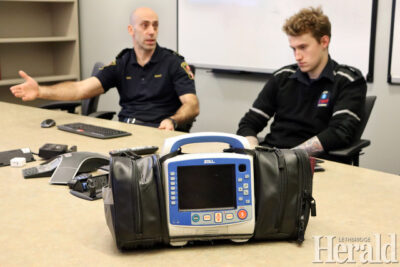New technology helping save lives in Lethbridge
By Lethbridge Herald on January 11, 2023.
 Herald photo by Al Beeber
Emergency Medical Services Operations Officer Mike Humphrey, left, talks about the CaseReview system being used by LFES at the downtown fire station on Wednesday.
Herald photo by Al Beeber
Emergency Medical Services Operations Officer Mike Humphrey, left, talks about the CaseReview system being used by LFES at the downtown fire station on Wednesday.Al Beeber – LETHBRIDGE HERALD – abeeber@lethbridgeherald.com
Lethbridge Fire and Emergency Services has implemented new protocols that are saving the lives of cardiac patients.
A cardiac monitoring system called CaseReview that was purchased along with new cardiac monitors in 2020 has increased the number of cardiac patients resuscitated by LFES crews arriving at the hospital with a pulse, to 90 per cent.
Before the CaseReview software program was utilized, only 50 per cent of patients arrived at hospital with a pulse.
Mike Humphrey, EMS operations officer, said Wednesday that CaseReview enables crews to monitor patients and provide trends to create guidelines to see patients have the best possible outcome after cardiac arrest.
His meeting with media came just after he and a crew did a review of a morning case which Humphrey said didn’t have a good outcome.
CaseReview enables EMS crews to play back events and analyze what they did right and what could be improved, giving them confidence in their approaches to dealing with cardiac patients, said Humphrey.
The Lethbridge department is one of the few in Alberta using the system, and its protocols were developed with Alberta Health Services.
“We record and are able to play back in real time all the events,” said Humphrey after crews went over the morning’s call.
He said the lessons learned from evaluating an event could be applied by crews later on in a shift.
“That’s really the advantage to being able to capture all this data – that we can learn in real time” for next time, he said.
Crews have so far captured more than 200 events with CaseReview, he said.
“Medical science is very clear on what we need to happen but the art form is when should we do the intervention, what can wait to get to the hospital, what can wait to get to an ambulance…so our members can intervene with confidence that they’re doing the right thing at the right time,” said Humphrey.
One identified trend is that cardiac patients who regain a pulse have extremely low blood pressure in 50 per cent of cases. By addressing that quickly with medication, EMS crews can avoid a second cardiac arrest which improves the chance of survival.
The change has brought a treatment normally used in ICU to the first responders on scene.
A monitor keeps track of every time EMS staff do a compression and every time they provide ventilation. All vital signs are put into an intuitive program that can be replayed, said Humphrey.
Ventilation performance can also be examined, he said. C02 is also tracked which gives clues to what treatment is most appropriate.
Analyzing data allows EMS to objectively say it did everything possible to help a patient survive.
“A lot of agencies are using this as just a simple report card, how you do. What we’re doing is we’re looking at provider trends and patient trends and looking at enabling providers to make predictions on what the patient will do and intervene before they deteriorate,” said Humphrey.
“There’s not many agencies around North America doing that and we happen to be one of the first ones to adopt this technology to get better as a system.”
In a press release, AHS South Zone medical director Aaron Low commended Lethbridge EMS “for leading this innovative work through the implementation of CaseReview technology. By identifying gaps and adjusting in real-time while in the field, they have significantly improved the outcomes for patients in distress. This is a critical benefit for the individual in care and extends to their families as a result of their success.”
Follow @albeebHerald on Twitter
23-22




